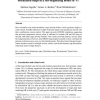Free Online Productivity Tools
i2Speak
i2Symbol
i2OCR
iTex2Img
iWeb2Print
iWeb2Shot
i2Type
iPdf2Split
iPdf2Merge
i2Bopomofo
i2Arabic
i2Style
i2Image
i2PDF
iLatex2Rtf
Sci2ools
IJON
2006
2006
Prenatal development of ocular dominance and orientation maps in a self-organizing model of V1
How orientation and ocular-dominance maps develop before visual experience begins is controversial. Possible influences include molecular signals and spontaneous activity, but their contributions remain unclear. This paper presents LISSOM simulations suggesting that previsual spontaneous activity alone is sufficient for realistic OR and OD maps to develop. Individual maps develop robustly with various previsual patterns, and are aided by background noise. However, joint OR/OD maps depend crucially on how correlated the patterns are between eyes, even over brief initial periods. Therefore, future biological experiments should account for multiple activity sources, and should measure map interactions rather than maps of single features. Key words: Ocular dominance maps, Orientation maps, Development, Visual cortex, Spontaneous activity
| Added | 13 Dec 2010 |
| Updated | 13 Dec 2010 |
| Type | Journal |
| Year | 2006 |
| Where | IJON |
| Authors | Stefanie Jegelka, James A. Bednar, Risto Miikkulainen |
Comments (0)

